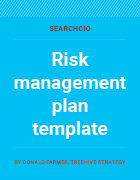How to create a risk management plan: Template, key steps
A risk management plan provides a framework for managing business risks. Here's what it includes and how to develop one, plus a downloadable plan template.
From supply chain disruptions and cybersecurity threats to regulatory changes, economic volatility and more, the risks that can derail projects, disrupt business operations or damage a company's reputation are varied and increasingly complex. A risk management plan guides how an organization navigates the uncertainties resulting from these business risks. It serves as a systematic framework for identifying, assessing and responding to them.
Rather than hoping for the best, organizations with a sound risk management plan can anticipate risk-related difficulties with well-prepared responses and can continue to operate with stability even in precarious circumstances. This article outlines the key components of a risk management plan and the steps to take to create an effective one that enables confident decision-making in managing the various types of risk an organization faces.
Why do organizations need a risk management plan?
Organizations that operate without a formal risk management plan essentially leave their success to chance. A structured approach to risk management provides the following benefits:
- Proactive problem prevention. Risk management plans enable organizations to identify potential issues before they escalate. The best way to create safeguards against risk is to systematically examine vulnerabilities across all business areas, aiming to prevent problems instead of reacting to them after they occur.
- Improved resource allocation. Understanding which risks pose the greatest threats enables organizations to allocate limited resources more effectively. Rather than spreading risk management efforts too thin, companies can focus their attention and budget on the risks that could have the most significant impact on their operations.
- Enhanced decision-making. When business leaders understand the potential risks associated with different strategies and tactical options, they can make better-informed choices about which opportunities to pursue -- and which to avoid. This high level of risk awareness supports decision-making at all levels of an organization.
- Stronger regulatory compliance. Many industries require formal risk management processes to comply with regulatory standards. Even in ones that don't, a risk management plan helps organizations meet applicable regulatory requirements and avoid potential compliance risk.
- Increased confidence among external stakeholders. Demonstrating a systematic approach to risk management builds confidence among customers, business partners and investors who want assurance that the organization can handle risks effectively.
- Better cost controls and business continuity. An effective risk management plan reduces the likelihood of expensive disruptions, emergency responses and crisis management situations. As a result, an organization should also experience fewer operational surprises and problems over time.
- Competitive advantages. While competitors that are less mature on risk management struggle with unforeseen challenges, organizations with comprehensive and well-planned risk programs can continue to operate smoothly and capitalize on business opportunities that arise during industry disruptions.
Key elements of a risk management plan
The following risk management components can be developed separately, but they work better together as part of a formal plan for managing risk in an organization. They're also included in the downloadable risk management plan template linked to here. The template can be used as the model for a plan or modified as needed to fit your organization's specific requirements.
Risk identification framework
The foundation of any risk management plan is a systematic approach to identifying potential risk threats. This framework should specify how risks will be identified across all business areas, including operational processes, financial systems, technology infrastructure, the regulatory environment and external market conditions. Also, the risk identification process should be ongoing rather than a one-time exercise, with regular reviews and updates as business conditions change.
Risk assessment framework
A risk management plan requires principles and a process for assessing the probability and possible impact of identified risks and then prioritizing them. An organization should aim to create consistent standards for measuring risks across different business areas to enable meaningful comparisons and ensure that the resulting risk management priorities are broadly understood. A well-designed risk assessment methodology considers both quantitative factors, such as potential financial losses, and qualitative elements, such as reputational damage or regulatory consequences.
Risk assessment matrix
Risk management teams commonly use a risk assessment matrix, also known as a risk priority matrix, to communicate the results of assessments to the organization. An assessment matrix can be included in a risk management plan as a table or a color-coded heat map, with scores assigned to different risks based on the probability they'll occur and their potential business impact.
Risk response strategy framework
For each category of risk an organization faces, its plan must outline the types of responses available and the criteria that will guide business executives and risk managers in selecting appropriate strategies for managing the risks. The available options are avoiding risks entirely, transferring them to or sharing them with other parties, mitigating their impact, or accepting them if they're within the organization's risk appetite and tolerance levels or if the cost of prevention exceeds the potential damage.
Risk management roles and responsibilities
Effective risk management demands clear involvement and accountability throughout the organization. A plan should list key roles and their risk management responsibilities. That includes not only risk managers but also senior executives, business managers and operational workers.
Risk register
A risk register records the various risks an organization needs to manage, along with information about their probability, potential impact and priority level. It also documents risk owners, response plans and more. Risk management plans should include a comprehensive risk register to help organizations track individual risks and the work done to manage them.
Risk monitoring and reporting systems
Risk management requires continuous oversight. A plan should establish systems for tracking identified risks, monitoring how well risk management initiatives are working, and reporting status information to appropriate stakeholders. This includes defining key risk indicators (KRIs) that can warn of potential issues, establishing review schedules and creating communication protocols for different types of risk events.
Documentation and record-keeping policies
Consistent risk management practices need clear documentation, which also provides evidence of due diligence for regulatory and legal purposes. The risk management plan should specify what information will be recorded, how it will be stored and accessed, and how long different types of records will be retained.
Steps for creating a risk management plan
Here are the key steps to take when developing a risk management plan. As you might expect, they align with the elements detailed in the previous section.
1. Conduct a comprehensive risk identification process
Begin by examining your organization from different perspectives to identify potential risks. To this end, organize sessions with teams from different departments to review historical risk incidents and current business operations. Analyze industry trends and regulatory changes, and examine your supply chain and value chain for risk-related vulnerabilities.
Structured approaches, such as SWOT analysis, assumption testing and both scenario planning and scenario analysis, can be used to uncover risks that might not be immediately obvious. In all cases, be sure to consider risks across multiple categories, including strategic, operational, financial, regulatory, technology, reputational and other types of threats.
Document each identified risk, specifying the potential cause, possible impact and affected business areas. This is the basis of your organization's risk assessment framework.
2. Assess and prioritize risks
This step starts with risk analysis work that helps inform the assessment and prioritization process. To provide consistent criteria for assessing the probability and potential impact of different risks, you should create scoring scales that enable easy comparisons for deciding which risks to prioritize. Here are examples showing how these scales could be structured:
Risk probability scale. Use this scoring scale to assess how likely each risk is to occur based on historical data, industry trends and expert judgment among business executives and risk managers.
| Score | Likelihood | Description |
| 1 | Very low | Risk is unlikely to occur (less than 10% chance). |
| 2 | Low | Risk might occur but is uncommon (10-30% chance). |
| 3 | Medium | Risk has a moderate likelihood of occurring (30-60% chance). |
| 4 | High | Risk is likely to occur (60-80% chance). |
| 5 | Critical | Risk is almost certain to occur (over 80% chance). |
Risk impact scale. This can be used to assess the potential consequences if a risk becomes a real issue, considering the effects it could have on the organization.
| Score | Impact level | Description |
| 1 | Minimal | Minor disruption easily managed as part of normal operations. |
| 2 | Low | Some impact but manageable with existing resources. |
| 3 | Medium | Significant impact requiring management attention and additional resources. |
| 4 | High | Major impact that affects multiple business areas or key objectives. |
| 5 | Critical | Severe impact that could threaten business viability. |
Risk assessment matrix. You can then multiply the probability score by the impact score to determine the overall score and risk priority level. For example, risks with a score of 1 to 4 could be classified as low priority, 5 to 9 as medium, 10 to 16 as high, and 20 to 25 as critical. The results can be shown in a 5x5 matrix to help an organization set risk response plans and allocate sufficient resources to manage the most significant risks.
This matrix can be done in a simple table, but I recommend visualizing the relationship between risk probability and impact as a color-coded heat map. By doing so, risks that require immediate attention stand out compared with those that can be monitored and managed over time.

3. Develop risk response strategies
The next step is to decide on the most appropriate response to every identified risk -- or, at least, the significant ones -- in advance of impactful incidents, so your organization is ready to act. Base your choices on the organization's appetite and tolerance for risk, available resources and strategic or tactical business priorities. Then, create detailed action plans for each type of response.
Risk appetite is the amount of risk an organization is willing to accept to accomplish its business objectives. Writing a risk appetite statement that documents acceptable risk levels in different categories is a common precursor to developing risk response strategies. Organizations often also write risk tolerance statements that specify how much the risks associated with specific business initiatives can exceed the relevant risk appetite level.
Here are more details about the four primary response strategies mentioned previously:
- Risk avoidance. To avoid high-impact risks, an organization can take actions such as changing a project's scope, altering business processes or not targeting certain markets. Risk avoidance eliminates the risk entirely, but it can be costly and might limit business opportunities.
- Risk transfer or risk sharing. Risks can be transferred to or shared with other entities through insurance, outsourcing, partnerships and other contracts. Sharing or transferring risks reduces an organization's direct exposure to their potential impact. But it brings ongoing costs and a loss of direct control in managing risks.
- Risk mitigation. This reduces risks that are worth taking or unavoidable through measures such as employee training, business process improvements and implementation of backup systems. Effective risk mitigation limits the likelihood of risk-related incidents and their potential impact, but it requires ongoing resources.
- Risk acceptance. Low-priority, unavoidable or tolerable risks can be accepted without taking any risk reduction actions. As you might expect, risk acceptance is the lowest-cost response option. But organizations should create contingency funds in case accepted risks cause unexpected business problems that require mitigation measures.
It's also critical to have contingency plans for all risks that could severely affect business operations. An organization must be able to respond quickly if these threats materialize, so include specific steps to take, responsible parties, timelines for responding and required resources in the plans.
4. Assign risk ownership and specific roles and responsibilities
Designate individuals or teams as risk owners responsible for monitoring particular risks, implementing response measures and reporting on the status of efforts to manage the risks. Ensure that the risk owners understand their responsibilities, have access to necessary resources and are given appropriate authority to act when needed.
This step should also include documenting the roles and responsibilities of other participants in the risk management process. The table below provides an example of what that might involve.
| Role | Primary responsibilities | Key activities |
| Senior leadership | Set risk appetite levels, approve major strategies. | Strategic oversight, resource allocation, policy approval. |
| Risk managers | Coordinate and oversee risk management activities. | Plan development, training, reporting, process improvement. |
| Risk committee | Review and approve risk management decisions. | Plan and policy review, major decision-making, escalation handling. |
| Business managers | Identify and manage risks in departments and business units. | Risk assessment, implementation of risk controls, staff training. |
| All employees | Report risk events and follow risk management procedures. | Risk identification, compliance with policies, incident reporting. |
5. Map out the implementation of risk controls
This step details how to implement risk controls based on the risk response strategies and the roles and responsibilities decided previously. A risk register becomes a valuable tool here. As part of the control procedures, risk management activities should be integrated into current business processes rather than being treated as separate overhead functions.
Training and communication plans should also be developed at this stage, along with risk monitoring measures to provide early warning of emerging threats. This might include establishing KRIs and creating automated alerts or just regular risk review processes. Tools and processes for risk reporting should also be built into the risk management plan.
6. Create processes to monitor, review and update the plan
Establish ongoing processes for tracking the status of different risks, measuring the effectiveness of management efforts and identifying new or evolving risks. Create feedback loops that capture lessons learned from both successful risk management and instances where problems occur despite the planning. This information can be used to continuously improve risk identification, assessment and response capabilities.
Regular reviews of the entire risk management plan should also be conducted to ensure it remains current and effective as business conditions change. Schedule formal reviews of the plan at least annually, with more frequent updates as needed, based on significant business changes or emerging risks.
Eyeing the future of risk management in creating a plan
While traditional risk management approaches provide essential foundations for protecting an organization, the integration of AI and advanced analytics tools into the process is beginning to transform how enterprises identify, assess and respond to risks.
AI can analyze large volumes of diverse data to identify patterns that human analysts might miss, enabling more comprehensive risk discovery in complex business operations. Machine learning algorithms process historical incidents, market data, operational metrics and external signals to predict potential risk events before they occur, shifting risk management from reactive to proactive.
Incorporating broader data sets and more sophisticated modeling techniques should also improve risk analysis accuracy. In addition, real-time monitoring capabilities enable organizations to track KRIs continuously for more dynamic risk management.
Perhaps most significantly, there's the potential for human-AI collaboration in which the technology handles routine pattern recognition and initial analysis while risk management professionals focus on interpretation, strategic context and complex judgment calls. This combines the best capabilities of human expertise and machine-driven processing power.
Organizations building their risk management plan should be open to incorporating these technologies to help improve their risk intelligence and response capabilities. The goal is to create adaptive risk management systems that become more effective over time, enabling confident risk decision-making in an increasingly complex and fast-changing business environment.
Donald Farmer is a data strategist with 30-plus years of experience, including as a product team leader at Microsoft and Qlik. He advises global clients on data, analytics, AI and innovation strategy, with expertise spanning from tech giants to startups.









